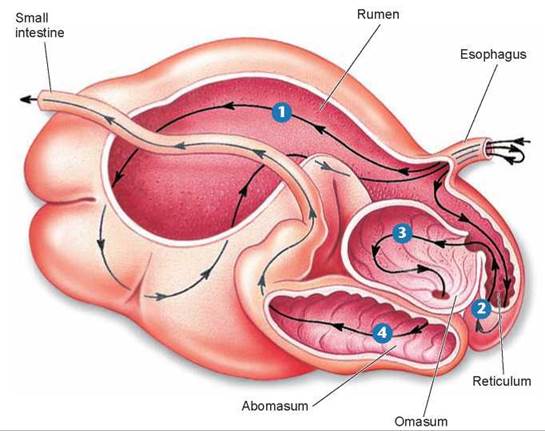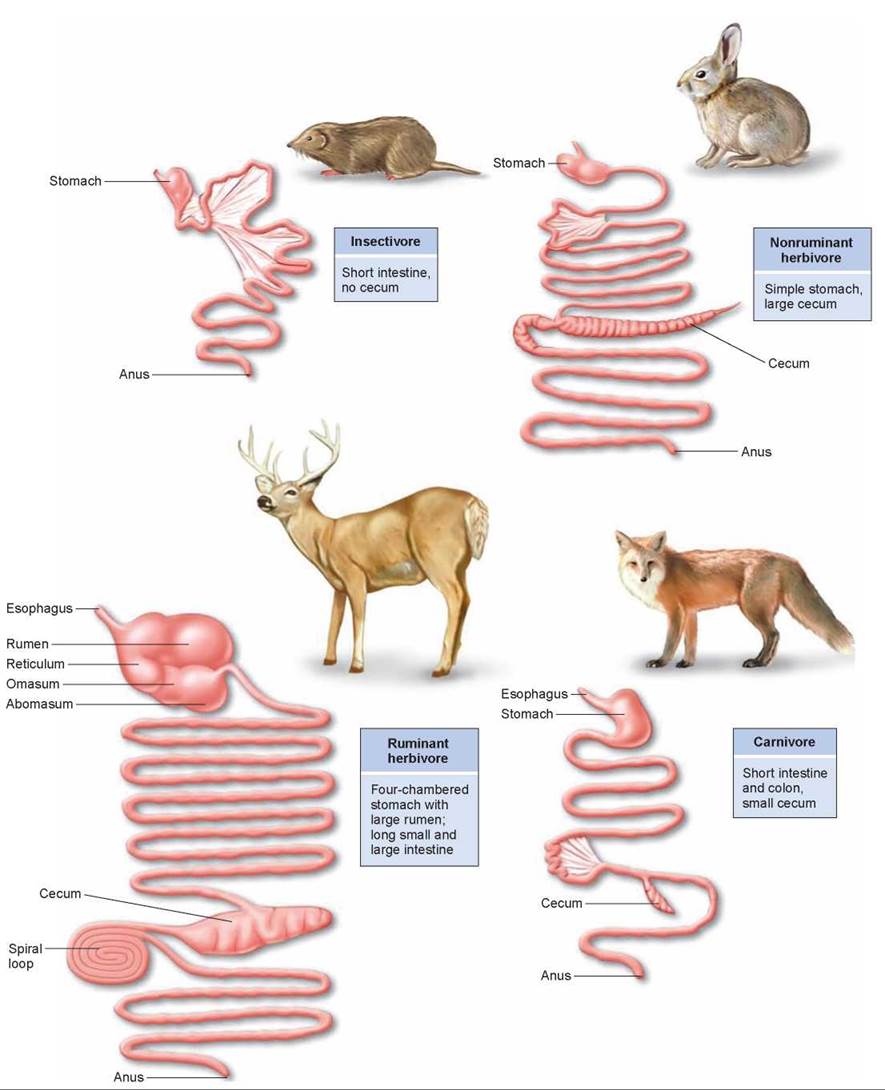THE LIVING WORLD
Unit Six. Animal Life
25. The Path of Food Through the Animal Body
25.7. Variations in Vertebrate Digestive Systems
Most animals lack the enzymes necessary to digest cellulose, the carbohydrate that functions as the chief structural component of plants. The digestive tracts of some animals, however, contain prokaryotes and protists that convert cellulose into substances the host can digest. Although digestion by gastrointestinal microorganisms plays a relatively small role in human nutrition, it is an essential element in the nutrition of many other kinds of animals, including insects like termites and cockroaches and a few groups of herbivorous mammals. The relationships between these microorganisms and their animal hosts are mutually beneficial and provide an excellent example of symbiosis.
Cows, deer, and other herbivores called ruminants have large, divided stomachs. By following the path food takes in figure 25.14, we can explore the areas of the stomach. Food enters the stomach by way of the rumen 1. The rumen, which may hold up to 50 gallons, serves as a fermentation vat in which prokaryotes and protists convert cellulose and other molecules into a variety of simpler compounds. The location of the rumen at the front of the four chambers is important because it allows the animal to regurgitate and rechew the contents of the rumen (see how the arrow leaves the stomach after looping through the rumen and reenters), an activity called rumination, or “chewing the cud.” The cud is then swallowed and enters the reticulum 2, from which it passes to the omasum 3 and then the abomasum 4, where it is finally mixed with gastric juice. Hence, only the abomasum is equivalent to the human stomach in its function. This process leads to a far more efficient digestion of cellulose in ruminants than in mammals that lack a rumen, such as horses.

Figure 25.14. Four-chambered stomach of a ruminant.
The grass and other plants that a ruminant, such as a cow, eats enter the rumen, where they are partially digested. From there, the food may be regurgitated and rechewed. The food is then transferred through the last three chambers. Only the abomasum secretes gastric juice.
In some animals such as rodents, horses, and lago- morphs (rabbits and hares), the digestion of cellulose by microorganisms takes place in the cecum, which is greatly enlarged in these animals (see the rabbit, a nonruminant herbivore, in figure 25.15). Because the cecum is located beyond the stomach, regurgitation of its contents is impossible. However, rodents and lagomorphs have evolved another way to digest cellulose that achieves a degree of efficiency similar to that of ruminant digestion. They do this by eating their feces, thus passing the food through their digestive tract a second time. The second passage makes it possible for the animal to absorb the nutrients produced by the microorganisms in its cecum. Animals that engage in this practice of coprophagy (from the Greek words copros, excrement, and phagein, eat) cannot remain healthy if they are prevented from eating their feces. The organization of the digestive system reflects the diet of the animal. Thus the large cecum of the rabbit reflects a diet of plants. In contrast, the insec- tivore and carnivore in figure 25.15 digest primarily protein from animal bodies; therefore, they have a reduced or absent cecum. Ruminant herbivores, as described earlier, have a large four-chambered stomach and also a cecum, although most digestion of vegetation occurs in the stomach.

Figure 25.15. The digestive systems of different mammals reflect their diets.
Herbivores require long digestive tracts with specialized compartments for the breakdown of plant matter. Protein diets are more easily digested; thus, insectivorous and carnivorous mammals have shorter digestive tracts with few specialized pouches.
Cellulose is not the only plant product that vertebrates can use as a food source because of the digestive activities of intestinal microorganisms. Wax, a substance indigestible by most terrestrial animals, is digested by symbiotic bacteria living in the gut of honeyguides, African birds that eat the wax in bees’ nests. In the marine food chain, wax is a major constituent of copepods (crustaceans in the plankton), and many marine fish and birds appear to be able to digest wax with the aid of symbiotic microorganisms.
Another example of the way intestinal microorganisms function in the metabolism of their animal hosts is provided by the synthesis of vitamin K. All mammals rely on intestinal bacteria to synthesize this vitamin, which is necessary for the clotting of blood. Birds, which lack these bacteria, must consume the required quantities of vitamin K in their food. In humans, prolonged treatment with antibiotics greatly reduces the populations of bacteria in the intestine; under such circumstances, it may be necessary to provide supplementary vitamin K.
Key Learning Outcome 25.7. Much of the food value of plants is tied up in cellulose, and the digestive tract of many animals harbors colonies of cellulose-digestive microorganisms.